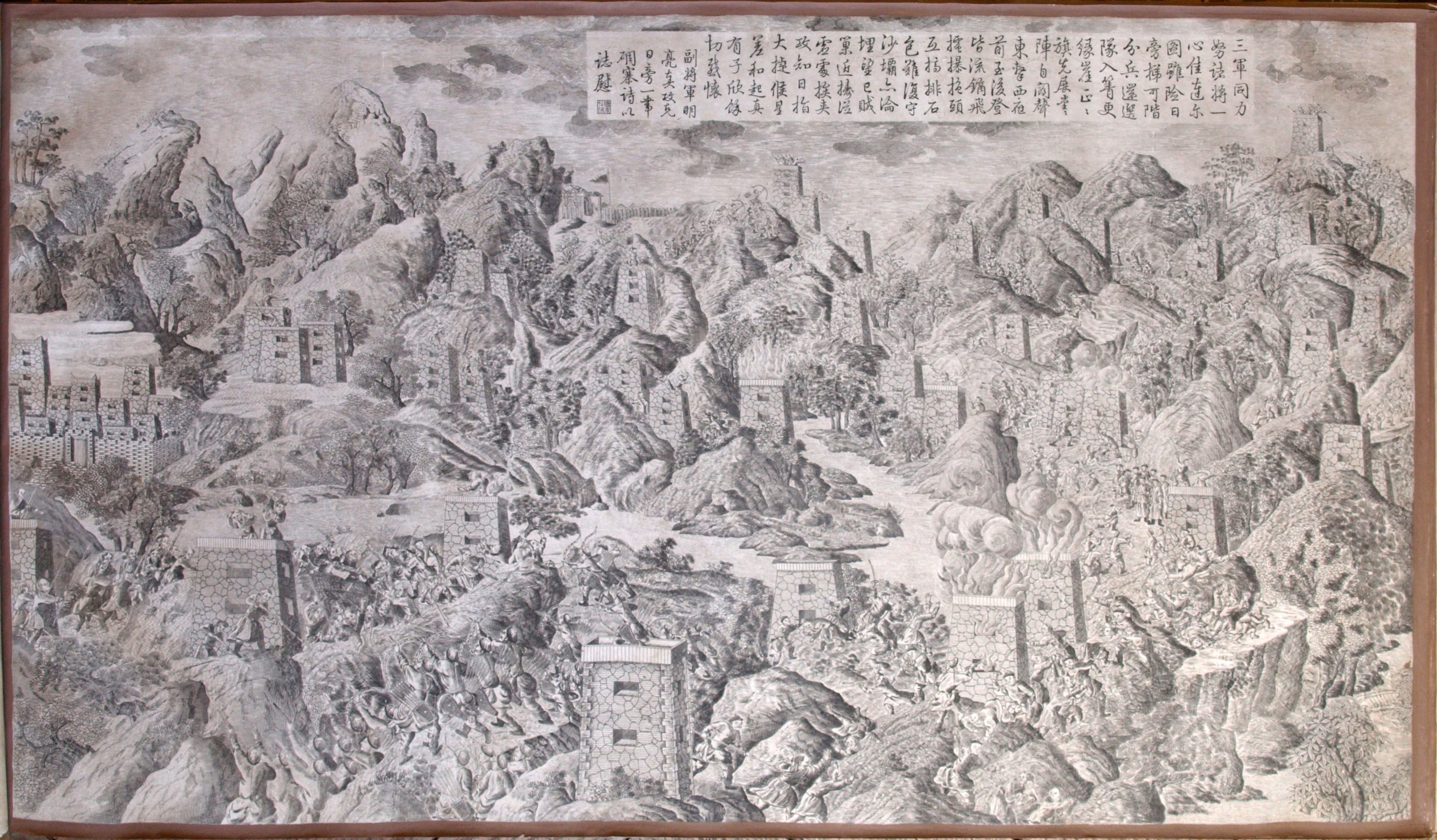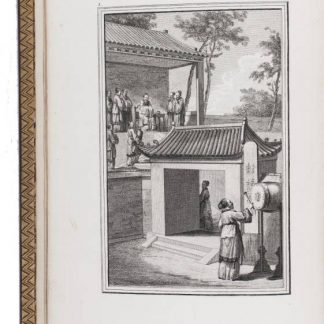First edition of Chinese series of enormous prints celebrating the Emperor's conquests in Sichuan
[Pingding Xiyu zhantu]. Suite of engravings representing the military campaigns at the conquest of Jinchuan.
Suite of 13 (out of 16) large copper-engraved plates (each measuring 505 x 864 mm approx.), laid down on slightly larger sheets with painted brown borders, with a printed poem in Chinese within each plate (based on Qianlong Emperor’s own personal commentary on the battles). Later morocco-backed and cornered marbled boards, cloth ties.
€ 480.000,00
Chinese issue, following the Paris printing of 1755-59. The “Battle Copper Prints” are a series of prints from copper engravings dating from the second half of the 18th century. They were commissioned by the Qianlong Emperor of the Qing dynasty, who ruled from 1735 to 1796. They depict his 1772-76 military campaigns, led by General A-Kuei, against the Jinchuan tribes in China’s inner provinces and along the country’s frontiers in the ethnically Tibetan mountain regions of Szechuan. The master illustrations for the engravings were large paintings executed by European missionary artists employed at that time at the court in Beijing. They included the Jesuits Giuseppe Castiglione (1688-1766), Jean-Denis Attiret (1702-68), and Ignaz Sichelbarth (1708-80), as well as the Augustinian missionary Giovanni Damasceno Sallusti (d. 1781). The engravings of the first set of 16 paintings were not produced in China but in Paris, at that time home to the best European artisans working in this technique. The Emperor even decreed that the work must emulate the style of the Augsburg engraver Georg Philipp Rugendas (1666-1742), whose work he knew. Small-scale copies of the paintings by Castiglione and his Beijing colleagues were sent to Paris to be transferred onto copperplates, printed, and then sent back to China, along with the plates and prints. Later sets of engravings were executed in Beijing by Chinese apprentices of the Jesuits and differ markedly in style and elaborateness from those of the Paris series.
In the history of Chinese art, copper-print engraving remained an episode. Qianlong's "Battle Copper Prints" were just one of the means the Manchu emperor employed to document his campaigns of military expansion and suppression of regional unrest. They served to glorify his rule and to exert ideological control over Chinese historiography. Seen in their political context, they represent a distinct and exceptional pictorial genre and are telling examples of the self-dramatization of imperial state power. Later campaigns of Qianlong which were similarly commemorated include Taiwan (1786-88), Annam or Vietnam (1788), Gurkhas invasion of Tiber (1790), and Yunnan, Guizhou and Hunan (1795-1796).
The striking plates comprising this set appear to be examples of the Chinese versions printed later, with Chinese text within the plates and technical and stylistic differences which differ greatly from the earlier Paris "westernized" versions executed under the supervision of the accomplished Charles-Nicolas Cochin (1715-90). Such a large complement from this suite of sixteen from the Chinese printing is extremely rare: while copies of the earlier Paris printing have appeared on the market (a complete set sold at Christie’s Paris, on 29 Oct. 2012), we have been unable to trace a comparable copy of the Chinese issue. The Getty Research Institute owns a suite depicting one of Qianlong’s last print commissions, produced nearly 30 years after the first series, the "Ping ding Kuoerke zhan tu" ("Pictures of the Campaigns against the Gurkhas"), which likewise stands out as a highly unusual example of Chinese images executed with European graphic techniques. The Getty’s suite is the only complete set in American public collections of this later work. The Taipei Palace Museum has a complete set of this series with the Chinese text apparently of the same issue.
In perfect condition. From the collection of Jean R. Perrette.
Shiqu Baoji, Imperial Catalogue. Chuang Chi-fa, Taipei Palace Museum - Ten Military Campaigns of Qianlong Emperor. W. Fuchs, in: Monumenta Serica, 4 (1939-40), p. 122. Paul Pelliot, "Les 'Conquêtes de l'Empereur de la Chine'", in: Toung pao 20 (1921), pp. 183-274. S. L. Shaw, Imperial printing, p. 22. Takata Tokio, "Qianlong Emperor's Copperplate Engravings of the 'Conquest of Western Regions'", in: The Memoirs of the Tokyo Bunko 70 (2012).


















